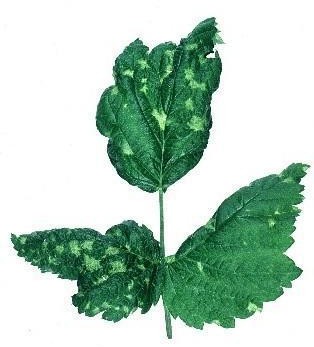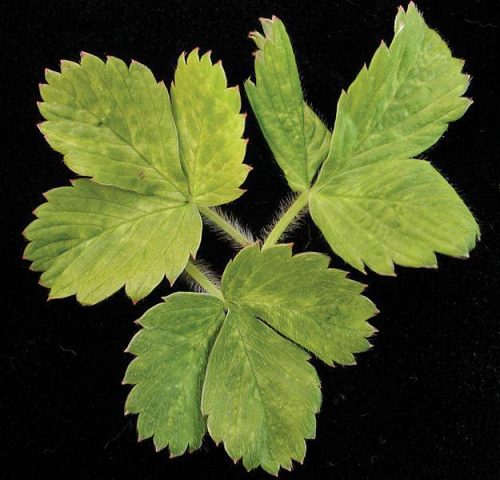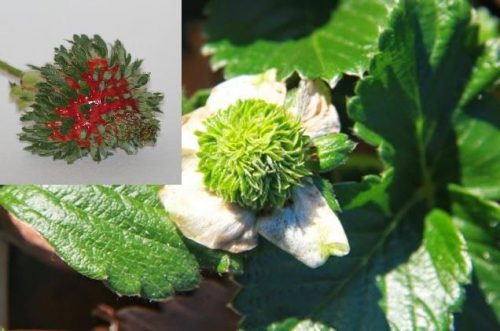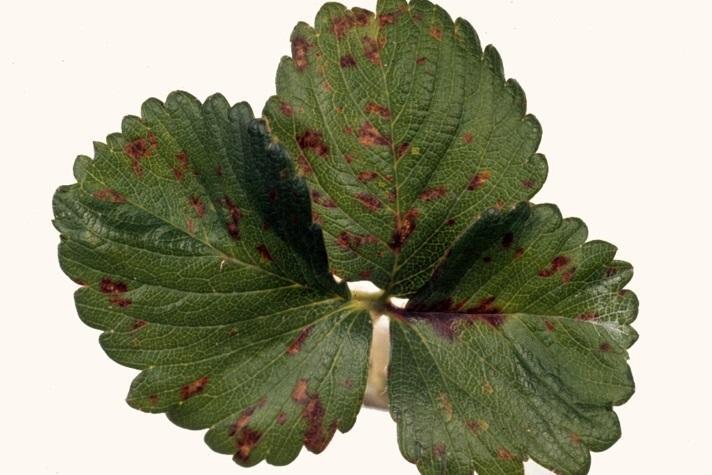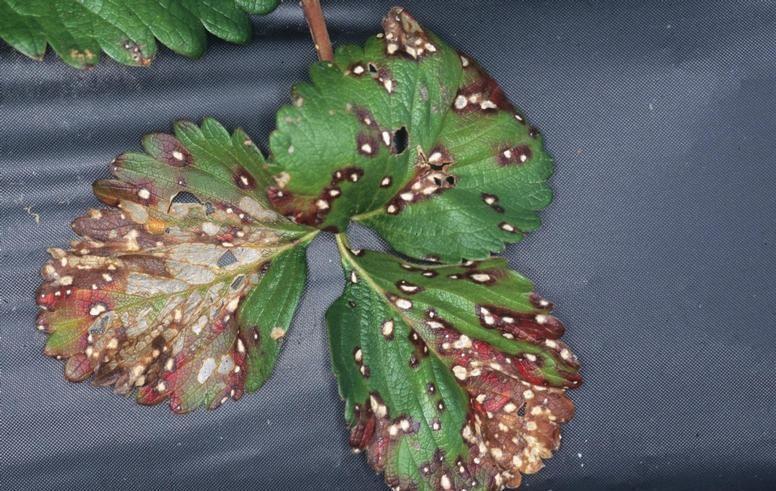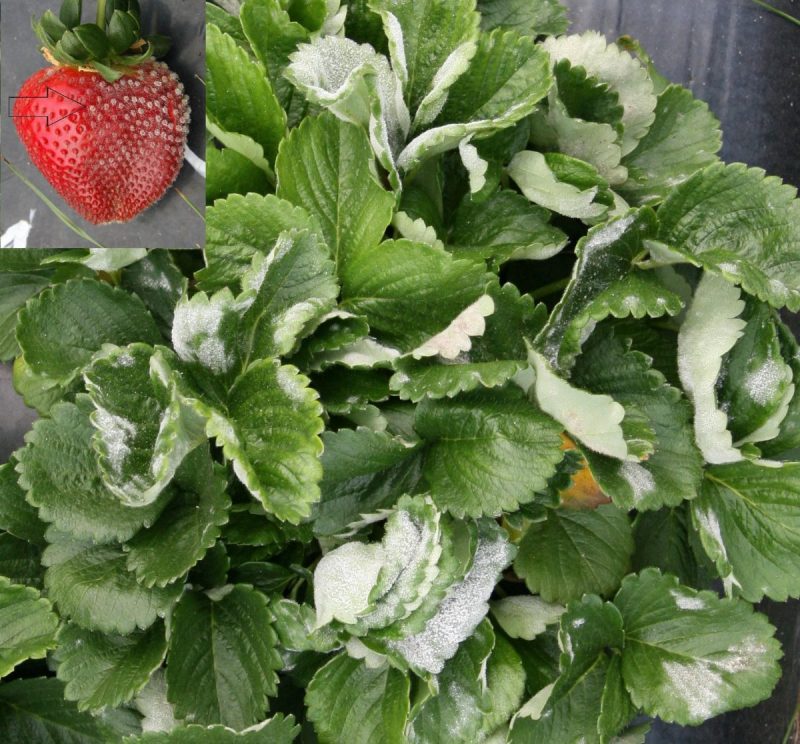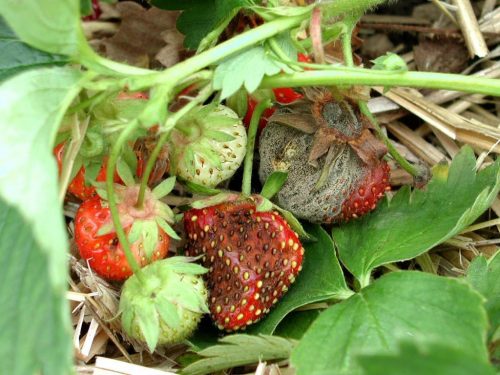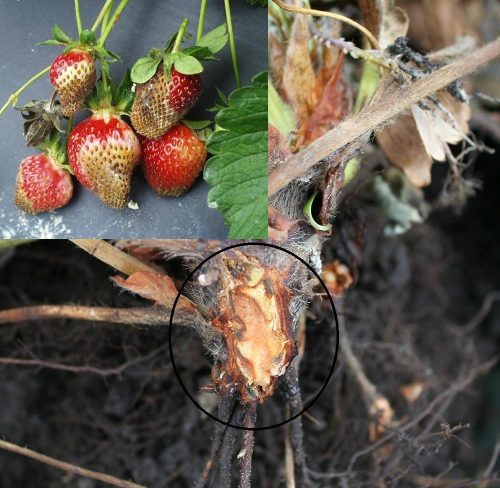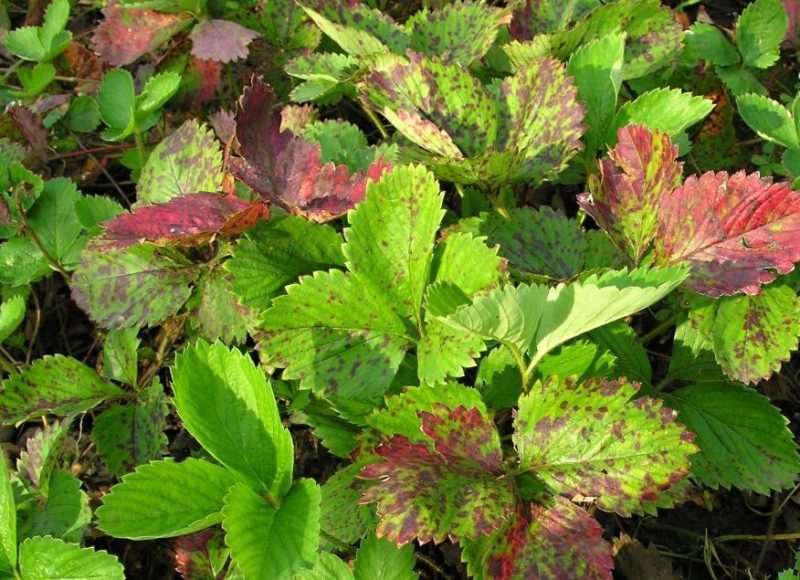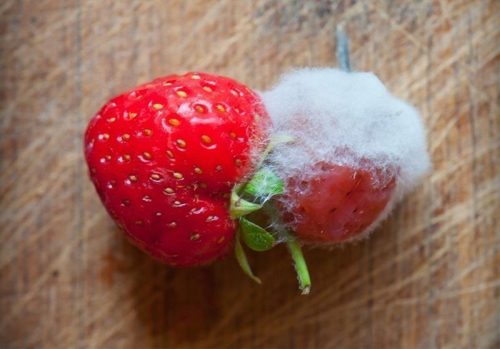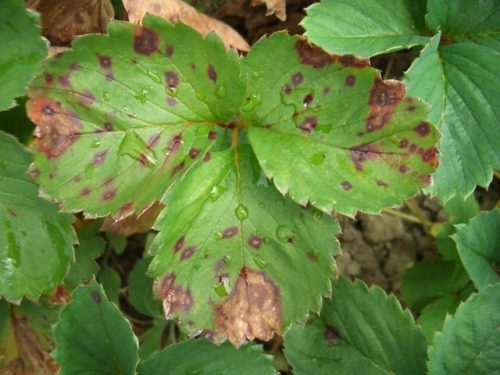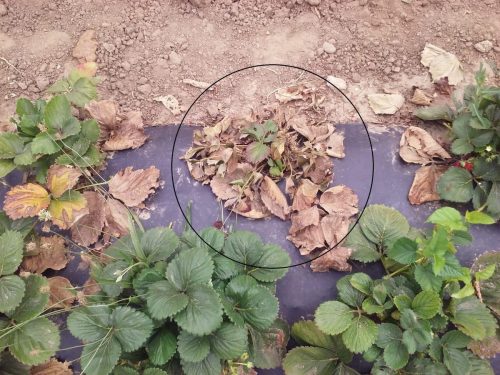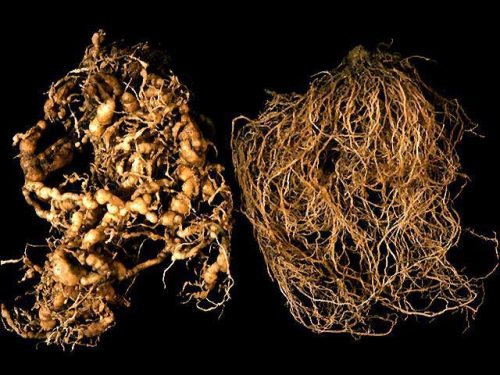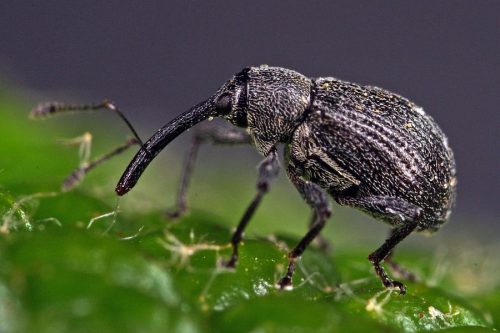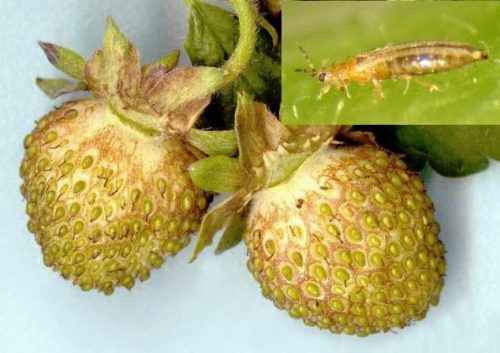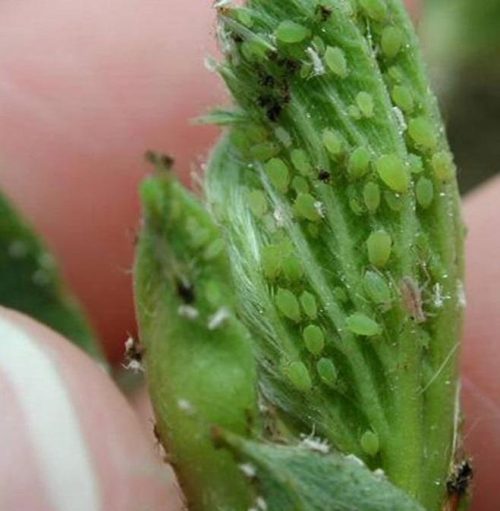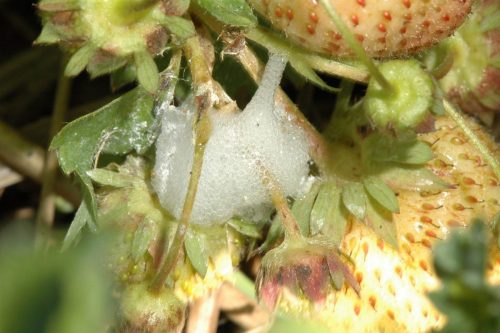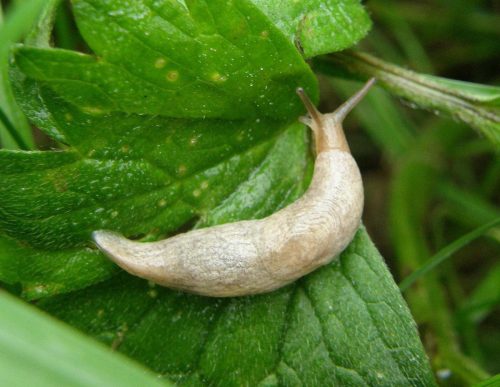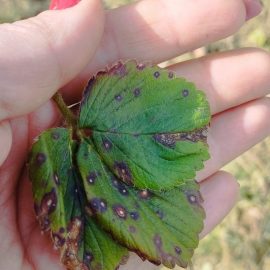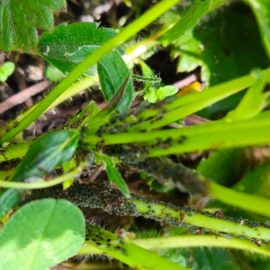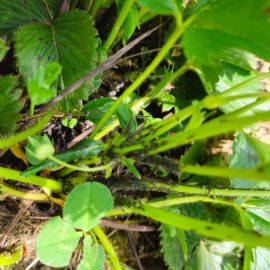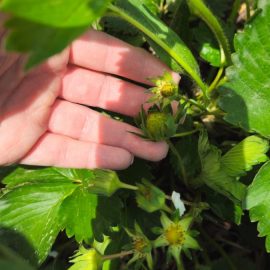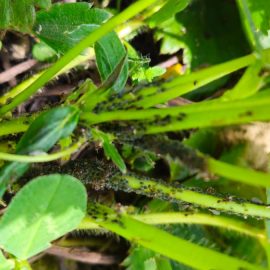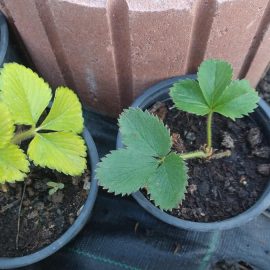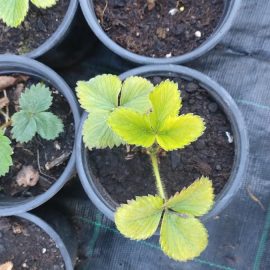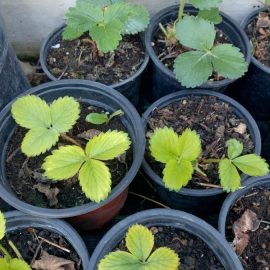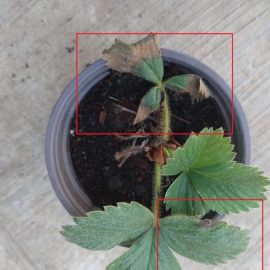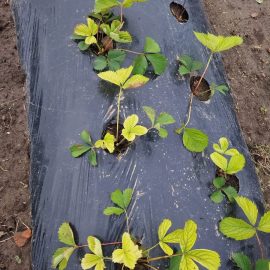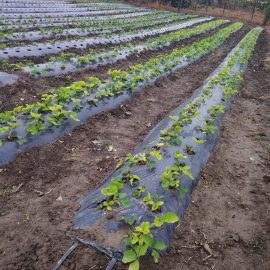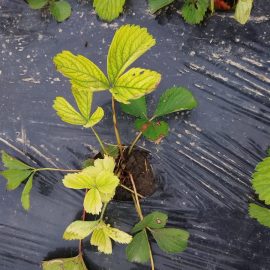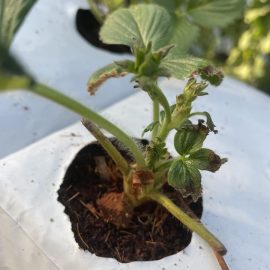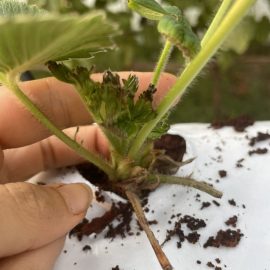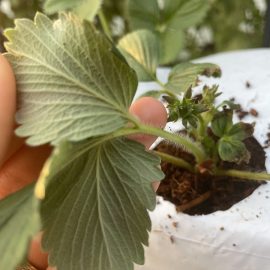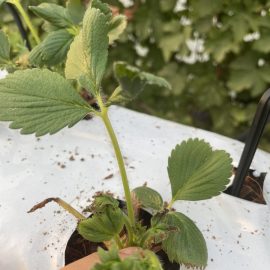Strawberry treatments, pest and disease control
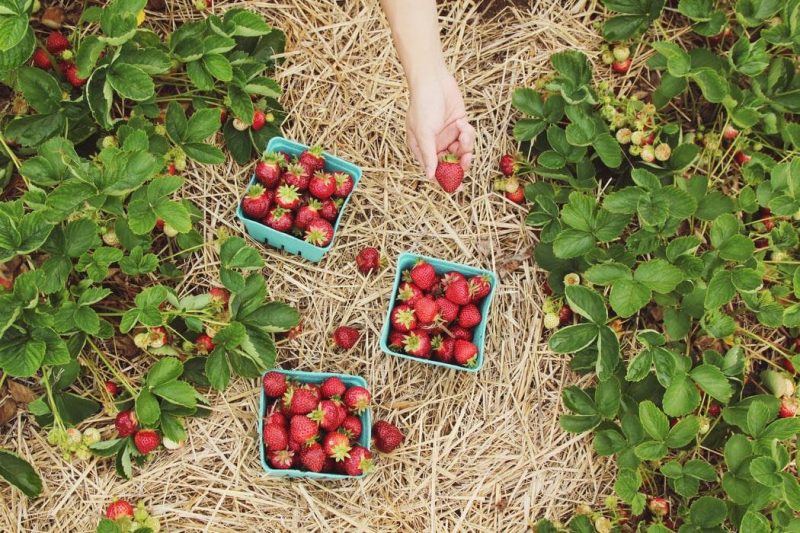
The strawberry (Fragaria x ananassa) is a fruit-bearing shrub species, being very appreciated due to its tasty fruits. Strawberry plants have high ecological plasticity, successfully cultivated in many geographical areas and different environmental conditions. Strawberrys are a profitable species (it bears fruit in the first year after planting). The main problems are the high perishability of the fruit and the high costs of harvesting. The fruits have a high nutritional value. They are recommended in case of liver diseases, hypertension, anemia, asthenia, convalescence, and detoxification cures. They contain sodium, potassium, protein, magnesium, iron, calcium, and vitamins (A, D, C, B6, B-12).
The main diseases of strawberry plants
VIRUSES
Strawberry latent ringspot virus
This virus attacks several species of woody and herbaceous plants. The attacked plants stagnate and show yellow spots on the leaves. The disease is transmitted through nematodes and infected planting material.
Prevention and control measures:
- using healthy planting material;
- soil disinfection (especially if the presence of nematodes has been reported).
Strawberry mottle virus
Discoloration spots appear on the leaves, arranged along the veins. In time, the veins become also discolored and the leaves curl up. This virus is transmitted by aphids.
Prevention and control measures:
- growing resistant strawberry varieties and hybrids;
- applying insecticides to keep the aphid population under control.
Recommended products
-
You can find products on a different store
Change Store -
You can find products on a different store
Change Store -
You can find products on a different store
Change Store -
You can find products on a different store
Change Store -
You can find products on a different store
Change Store -
You can find products on a different store
Change Store -
You can find products on a different store
Change Store -
You can find products on a different store
Change Store -
You can find products on a different store
Change Store -
You can find products on a different store
Change Store -
You can find products on a different store
Change Store -
You can find products on a different store
Change Store -
You can find products on a different store
Change Store -
You can find products on a different store
Change Store -
You can find products on a different store
Change Store -
You can find products on a different store
Change Store -
You can find products on a different store
Change Store -
You can find products on a different store
Change Store -
You can find products on a different store
Change Store -
You can find products on a different store
Change Store -
You can find products on a different store
Change Store -
You can find products on a different store
Change Store -
You can find products on a different store
Change Store -
You can find products on a different store
Change Store
MYCOPLASMOSIS
Strawberry mycoplasma
The petals turn green and the floral elements transform into leaf-like formations. The young leaves have a chlorotic appearance, are poorly developed, and twisted towards the topside. Also, fruits can turn into vegetative organs. The affected plants dry out prematurely. This disease lives on weed species (eg. bindweed, dodder) and is transmitted by some leafhoppers species.
Prevention and control measures:
- checking the planting material before planting;
- applying insecticides to keep the insect population under control.
BACTERIOSIS
Angular leaf spot of strawberry (Xanthomonas fragariae)
It is also known as the ‘leaf blight of strawberry’. As the common name suggests, blackish-brown angular spots appear on the leaves, bordered by veins. The spots enlarge in time and merge, destroying the entire surface of the leaves. In conditions of high humidity, a viscous layer is formed on the surface of the spots, which represents the bacterial ooze. The attacked tissues are destroyed and detached from the plant. The bacteria live on plant debris on the soil surface and are transmitted via the bacterial ooze.
Prevention and control measures:
- gathering and burning plant debris from the soil surface;
- chemical treatments with copper-based fungicides.
MYCOSIS
Leaf spot of strawberry (Mycosphaerella fragariae)
Small, greyish-white spots appear on the leaves, bordered by a purple edge. Later, a whitish fuzz appears on the surface of the spots, which represents the fungus fructification. Attacked tissues become necrotic and leaves become deformed. The disease frequently occurs in neglected plantations.
Prevention and control measures:
- growing resistant strawberry varieties;
- removing old and diseased leaves;
- chemical treatments with specific fungicides.
Recommended products
-
You can find products on a different store
Change Store -
You can find products on a different store
Change Store -
You can find products on a different store
Change Store -
You can find products on a different store
Change Store -
You can find products on a different store
Change Store -
You can find products on a different store
Change Store -
You can find products on a different store
Change Store -
You can find products on a different store
Change Store -
You can find products on a different store
Change Store -
You can find products on a different store
Change Store -
You can find products on a different store
Change Store -
You can find products on a different store
Change Store -
You can find products on a different store
Change Store -
You can find products on a different store
Change Store -
You can find products on a different store
Change Store -
You can find products on a different store
Change Store -
You can find products on a different store
Change Store -
You can find products on a different store
Change Store -
You can find products on a different store
Change Store -
You can find products on a different store
Change Store -
You can find products on a different store
Change Store -
You can find products on a different store
Change Store -
You can find products on a different store
Change Store -
You can find products on a different store
Change Store
Powdery mildew of strawberry (Podosphaera aphanis)
This fungus attacks all the aerial organs of the plant. A white felt develops on the infected organs. This felt becomes powdery when the fungus fructification emerges. The attacked leaves and fruits remain small and deformed. Thus, the plant is weakened and the fruits lose their aesthetic and commercial value.
Prevention and control measures:
- avoiding sprinkler irrigation systems;
- removing attacked leaves and fruits from the crop;
- chemical treatments with specific fungicides.
Recommended products
-
You can find products on a different store
Change Store -
You can find products on a different store
Change Store -
You can find products on a different store
Change Store -
You can find products on a different store
Change Store -
You can find products on a different store
Change Store -
You can find products on a different store
Change Store -
You can find products on a different store
Change Store -
You can find products on a different store
Change Store -
You can find products on a different store
Change Store -
You can find products on a different store
Change Store -
You can find products on a different store
Change Store -
You can find products on a different store
Change Store -
You can find products on a different store
Change Store -
You can find products on a different store
Change Store -
You can find products on a different store
Change Store -
You can find products on a different store
Change Store -
You can find products on a different store
Change Store -
You can find products on a different store
Change Store -
You can find products on a different store
Change Store -
You can find products on a different store
Change Store -
You can find products on a different store
Change Store -
You can find products on a different store
Change Store -
You can find products on a different store
Change Store -
You can find products on a different store
Change Store
Gray mold (Botrytis cinerea)
The fungus appears on the leaves at the base of the plant, and if the humidity remains high, it can move to the flowers and fruits. Attacked organs become covered with a greyish mold and decay. The disease develops rapidly can destroy the fruits, and can spread to nearby plants.
Prevention and control measures:
- removing attacked plants from the crop;
- growing resistant strawberry varieties;
- chemical treatments with specific fungicides.
Recommended products
-
You can find products on a different store
Change Store -
You can find products on a different store
Change Store -
You can find products on a different store
Change Store -
You can find products on a different store
Change Store -
You can find products on a different store
Change Store -
You can find products on a different store
Change Store -
You can find products on a different store
Change Store -
You can find products on a different store
Change Store -
You can find products on a different store
Change Store -
You can find products on a different store
Change Store -
You can find products on a different store
Change Store -
You can find products on a different store
Change Store -
You can find products on a different store
Change Store -
You can find products on a different store
Change Store -
You can find products on a different store
Change Store -
You can find products on a different store
Change Store -
You can find products on a different store
Change Store -
You can find products on a different store
Change Store -
You can find products on a different store
Change Store -
You can find products on a different store
Change Store -
You can find products on a different store
Change Store -
You can find products on a different store
Change Store -
You can find products on a different store
Change Store -
You can find products on a different store
Change Store
Crown rot (Phytophthora cactorum)
This fungus attacks all the organs of the plant, but the obvious symptoms show on the aerial organs. Thus, the unripe fruit hardens and the ripe fruit turns pink and tastes bitter. In conditions of high humidity, high temperatures, and lack of ventilation, a whitish fuzz appears on the surface of the fruit, representing the fungus’ fructifications. If you section the fruit, you can see a spongy, pinkish-brown marrow.
Prevention and control measures:
- removing affected plants from the crop;
- preventive chemical treatments with specific fungicides.
Strawberry leaf scorch (Diplocarpon fragariae)
Small, circular, isolated, or united, reddish-purple spots appear on the leaves of strawberry plants. The disease progresses and the attacked tissues become necrotic and greyish. Following the attack, photosynthesis capacity is reduced and yields are low. This disease can be confused with the leaf spot of strawberries (Mycosphaerella fragariae).
Prevention and control measures:
- growing resistant strawberry varieties;
- removing old and diseased leaves;
- chemical treatments with specific fungicides.
Recommended products
-
You can find products on a different store
Change Store -
You can find products on a different store
Change Store -
You can find products on a different store
Change Store -
You can find products on a different store
Change Store -
You can find products on a different store
Change Store -
You can find products on a different store
Change Store -
You can find products on a different store
Change Store -
You can find products on a different store
Change Store -
You can find products on a different store
Change Store -
You can find products on a different store
Change Store -
You can find products on a different store
Change Store -
You can find products on a different store
Change Store -
You can find products on a different store
Change Store -
You can find products on a different store
Change Store -
You can find products on a different store
Change Store -
You can find products on a different store
Change Store -
You can find products on a different store
Change Store -
You can find products on a different store
Change Store -
You can find products on a different store
Change Store -
You can find products on a different store
Change Store -
You can find products on a different store
Change Store -
You can find products on a different store
Change Store -
You can find products on a different store
Change Store -
You can find products on a different store
Change Store
Soft rot (Rhizopus stolonifer)
This disease can attack fruit after harvest, during transport, or storage. A mold appears on the surface of the fruit accompanied by circular black formations, representing the fungus’ fructifications. This disease spreads rapidly and can destroy large quantities of fruits.
Prevention and control measures:
- using clean, disinfected packaging;
- ensuring air ventilation in warehouses;
- keeping the temperature low during transport and storage.
Leaf spot (Dentrophoma obscurans)
The attack occurs from spring to autumn on all aerial organs, with symptoms more common on leaves. The disease shows up as brownish-purple spots with an irregular shape. With time, the spots enlarge and turn brown, and the leaves dry up and fall off.
Prevention and control measures:
- growing healthy and resistant strawberry varieties and hybrids;
- avoiding excessive irrigation;
- destroying the affected leaves (by burning);
- chemical treatments with fungicides.
Recommended products
-
You can find products on a different store
Change Store -
You can find products on a different store
Change Store -
You can find products on a different store
Change Store -
You can find products on a different store
Change Store -
You can find products on a different store
Change Store -
You can find products on a different store
Change Store -
You can find products on a different store
Change Store -
You can find products on a different store
Change Store -
You can find products on a different store
Change Store -
You can find products on a different store
Change Store -
You can find products on a different store
Change Store -
You can find products on a different store
Change Store -
You can find products on a different store
Change Store -
You can find products on a different store
Change Store -
You can find products on a different store
Change Store -
You can find products on a different store
Change Store -
You can find products on a different store
Change Store -
You can find products on a different store
Change Store -
You can find products on a different store
Change Store -
You can find products on a different store
Change Store -
You can find products on a different store
Change Store -
You can find products on a different store
Change Store -
You can find products on a different store
Change Store -
You can find products on a different store
Change Store
Verticillium wilt (Verticillium dahliae)
The first symptoms include wilting of the basal leaves. Gradually, the wilting spreads to the whole plant. If a section is made by cutting, it will show a destroyed root system.
Prevention and control measures:
- chemical treatments applied to the soil with specific fungicides.
Nutritional deficiencies in strawberry cultivation
Besides disease symptoms, strawberry plants may show symptoms that indicate a lack of nutrients.
These disorders are difficult to identify, but they strongly influence production. In this regard, it is recommended to apply fertilizers in the specific development stages, when the plants need nutrients.
Due to the processes that take place in the soil, it is recommended to use different fertilization methods (by irrigation, foliar, etc.). Fertilization must also ensure a balance between the plant parts by applying NPK or NPK + microelements complex fertilizers.
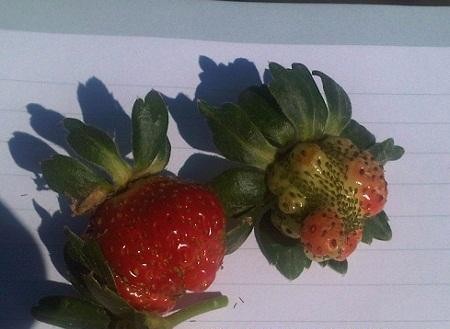
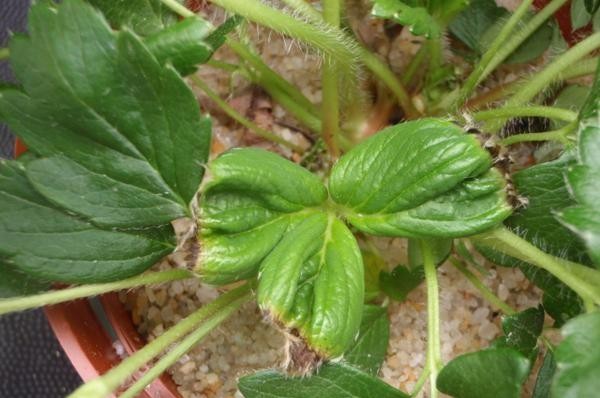
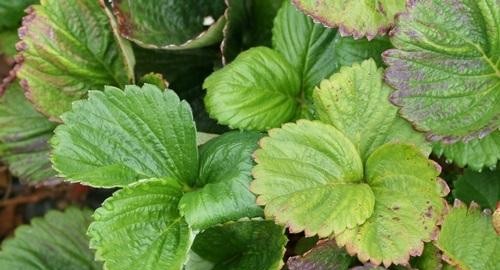
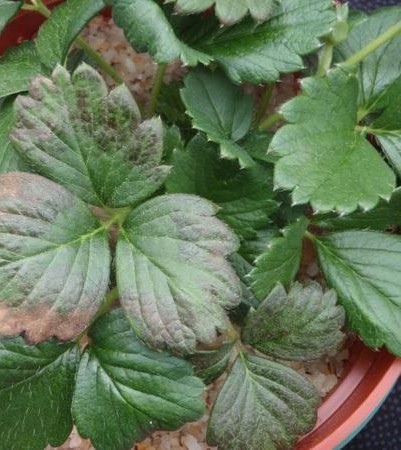
If a strawberry plantation is established, before carrying out agro-technical work ( plowing, etc.), it is recommended to apply well-fermented manure or NPK complex fertilizers, depending on the soil supply status, based on soil analysis. After planting, you can also apply a rooting stimulator.
Recommended products
-
You can find products on a different store
Change Store -
You can find products on a different store
Change Store -
You can find products on a different store
Change Store -
You can find products on a different store
Change Store -
You can find products on a different store
Change Store -
You can find products on a different store
Change Store -
You can find products on a different store
Change Store -
You can find products on a different store
Change Store -
You can find products on a different store
Change Store -
You can find products on a different store
Change Store -
You can find products on a different store
Change Store -
You can find products on a different store
Change Store -
You can find products on a different store
Change Store -
You can find products on a different store
Change Store -
You can find products on a different store
Change Store -
You can find products on a different store
Change Store -
You can find products on a different store
Change Store -
You can find products on a different store
Change Store -
You can find products on a different store
Change Store -
You can find products on a different store
Change Store -
You can find products on a different store
Change Store -
You can find products on a different store
Change Store -
You can find products on a different store
Change Store -
You can find products on a different store
Change Store
If the plantation is already established, it is recommended to apply NPK fertilizers in autumn to help the plants recover after the fruiting period.
Recommended products
-
You can find products on a different store
Change Store -
You can find products on a different store
Change Store -
You can find products on a different store
Change Store -
You can find products on a different store
Change Store -
You can find products on a different store
Change Store -
You can find products on a different store
Change Store -
You can find products on a different store
Change Store -
You can find products on a different store
Change Store -
You can find products on a different store
Change Store -
You can find products on a different store
Change Store -
You can find products on a different store
Change Store -
You can find products on a different store
Change Store -
You can find products on a different store
Change Store -
You can find products on a different store
Change Store -
You can find products on a different store
Change Store -
You can find products on a different store
Change Store -
You can find products on a different store
Change Store -
You can find products on a different store
Change Store -
You can find products on a different store
Change Store -
You can find products on a different store
Change Store -
You can find products on a different store
Change Store -
You can find products on a different store
Change Store -
You can find products on a different store
Change Store -
You can find products on a different store
Change Store
In spring, plants will need a supply of nutrients to start growing quickly. Fertilizing the plants when they start to grow helps them to be resistant to diseases and pests and helps them to form more flowers. It is recommended to apply NPK complex fertilizer and a foliar fertilizer with microelements.
Blooming phenophase
Once the first flowers appear, strawberry plants consume the highest amount of microelements during the growing season. For this reason, during flowering and fruit ripening, you can carry out 3-4 foliar fertilizations, at intervals of about 10 days, following the instructions on the label, depending on the product chosen. When the first flowers appear it is recommended to apply a boron-based product. Boron is an element that moves slowly through the plant and helps to transport sugars into the plant, taking part in the pollen germination process which helps to produce more fruits.
Fruit set phenophase
This is a phase when the plant needs Calcium, and it is recommended to apply a Calcium-based fertilizer during this period. Calcium has a structural role in the cell walls reducing the physiological phenomenon of fruit drop and making them more resistant to handling and storage.
Recommended products
-
You can find products on a different store
Change Store -
You can find products on a different store
Change Store -
You can find products on a different store
Change Store -
You can find products on a different store
Change Store -
You can find products on a different store
Change Store -
You can find products on a different store
Change Store -
You can find products on a different store
Change Store -
You can find products on a different store
Change Store -
You can find products on a different store
Change Store -
You can find products on a different store
Change Store -
You can find products on a different store
Change Store -
You can find products on a different store
Change Store -
You can find products on a different store
Change Store -
You can find products on a different store
Change Store -
You can find products on a different store
Change Store -
You can find products on a different store
Change Store -
You can find products on a different store
Change Store -
You can find products on a different store
Change Store -
You can find products on a different store
Change Store -
You can find products on a different store
Change Store -
You can find products on a different store
Change Store -
You can find products on a different store
Change Store -
You can find products on a different store
Change Store -
You can find products on a different store
Change Store
Veraison phenophase (start of fruit ripening)
This is an important moment to keep in mind when establishing fertilization technology. In this phase, the plants need more magnesium, which is the main element of chlorophyll. This element is involved in the plant’s metabolism and causes sugars, carbohydrates, proteins, and vitamins to accumulate, so the fruits will be bigger, stronger, and tastier.
Fruit ripening phenophase
This ends the fruiting period of the strawberry plants. It is recommended to apply foliar fertilizers based on Potassium during this phase. This element increases the crop weight, ripens the fruit uniformly, and improves the fruit taste.
The main pests of strawberry plants
Strawberry nematode (Aphelenchoides fragariae)
It has 6-8 generations per year and overwinters as an adult inside the affected plants and in the soil. It migrates through water droplets, penetrates plants, and lives inside them, feeding on plant’s sap. Following the attack, the flowering shoots are thickened and ramified. The growth of the young leaves is reduced. The attacked flowers and fruits remain undeveloped and sometimes deform.
Control measures:
- growing resistant strawberry varieties;
- using healthy planting material;
- disinfecting the soil with specific products.
Recommended products
-
You can find products on a different store
Change Store -
You can find products on a different store
Change Store -
You can find products on a different store
Change Store -
You can find products on a different store
Change Store -
You can find products on a different store
Change Store -
You can find products on a different store
Change Store -
You can find products on a different store
Change Store -
You can find products on a different store
Change Store -
You can find products on a different store
Change Store -
You can find products on a different store
Change Store -
You can find products on a different store
Change Store -
You can find products on a different store
Change Store -
You can find products on a different store
Change Store -
You can find products on a different store
Change Store -
You can find products on a different store
Change Store -
You can find products on a different store
Change Store -
You can find products on a different store
Change Store -
You can find products on a different store
Change Store -
You can find products on a different store
Change Store -
You can find products on a different store
Change Store -
You can find products on a different store
Change Store -
You can find products on a different store
Change Store -
You can find products on a different store
Change Store -
You can find products on a different store
Change Store
Strawberry mite (Tarsonemus fragariae)
It has 5-8 generations per year and overwinters as a female at the base of the leaf rosette. In spring, the females feed on the young leaves and then lay their eggs on the leaves. After hatching, the larvae colonize the plant’s organs, and following attack, the plants become weakened and may dry out within 1-2 years.
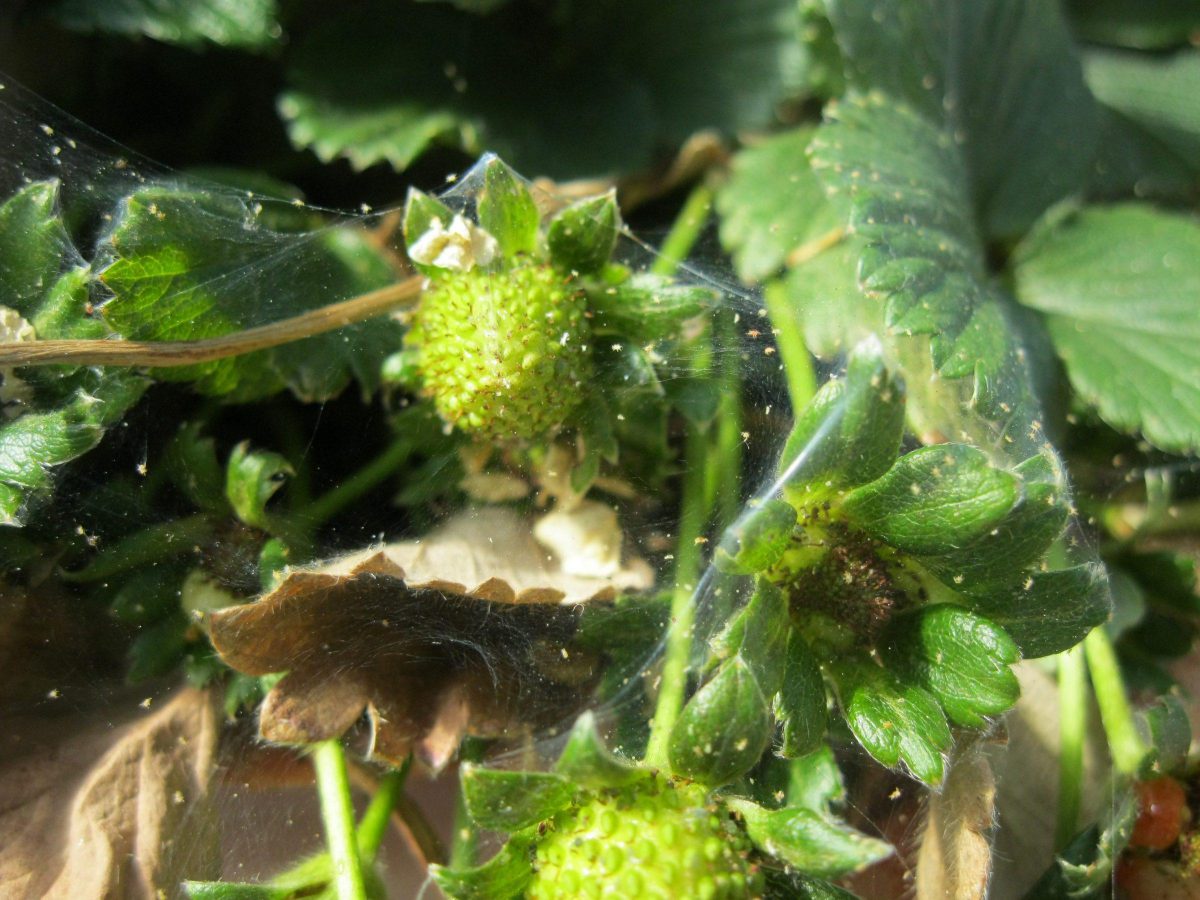
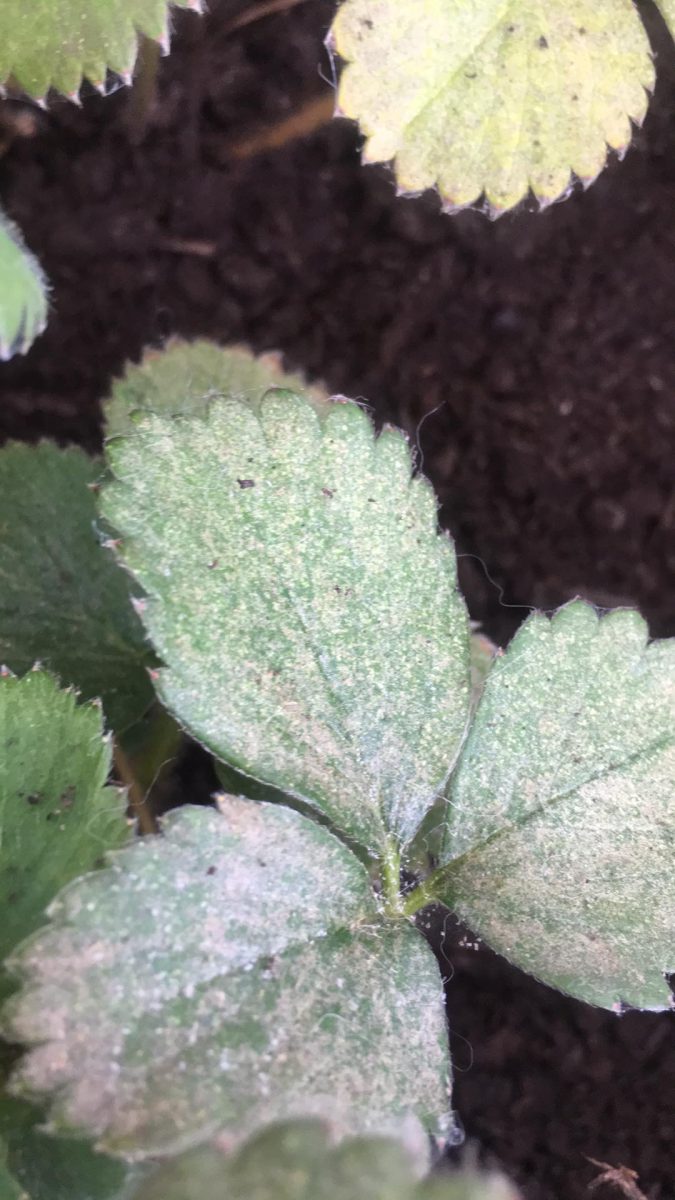
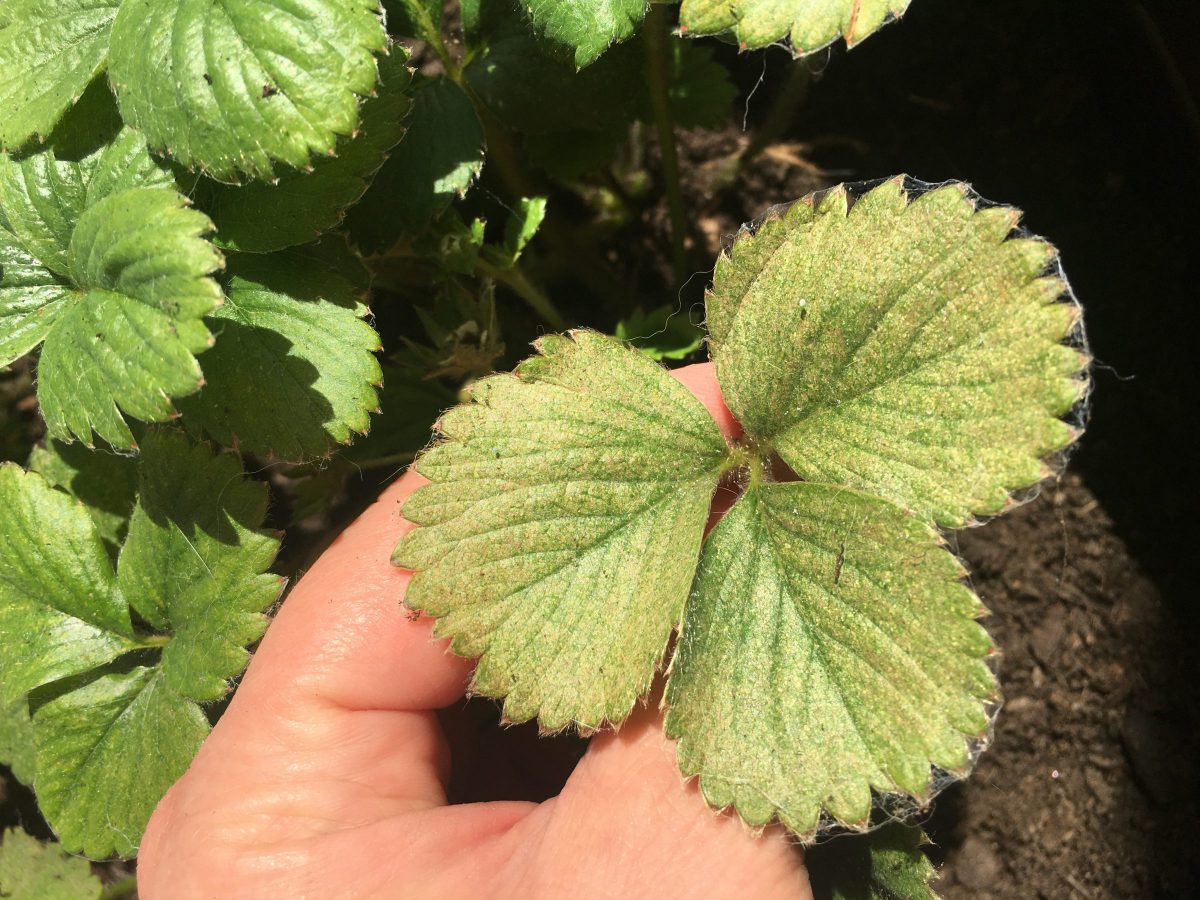
Control measures:
- growing resistant strawberry varieties;
- using healthy planting material;
- chemical treatments with specific products.
Recommended products
-
You can find products on a different store
Change Store -
You can find products on a different store
Change Store -
You can find products on a different store
Change Store -
You can find products on a different store
Change Store -
You can find products on a different store
Change Store -
You can find products on a different store
Change Store -
You can find products on a different store
Change Store -
You can find products on a different store
Change Store -
You can find products on a different store
Change Store -
You can find products on a different store
Change Store -
You can find products on a different store
Change Store -
You can find products on a different store
Change Store -
You can find products on a different store
Change Store -
You can find products on a different store
Change Store -
You can find products on a different store
Change Store -
You can find products on a different store
Change Store -
You can find products on a different store
Change Store -
You can find products on a different store
Change Store -
You can find products on a different store
Change Store -
You can find products on a different store
Change Store -
You can find products on a different store
Change Store -
You can find products on a different store
Change Store -
You can find products on a different store
Change Store -
You can find products on a different store
Change Store
Strawberry blossom weevil (Anthonomus rubi)
It has one generation per year and overwinters under the leaves or in the topsoil. In spring the adults feed on vegetative and flowering buds, then on young leaves and flower buds. The females lay eggs in the flower buds and the larvae consume the inside of the buds. Adults and larvae cause the most damage.
Control measures:
- gathering dry leaves from the ground;
- chemical treatments with specific insecticides.
Recommended products
-
You can find products on a different store
Change Store -
You can find products on a different store
Change Store -
You can find products on a different store
Change Store -
You can find products on a different store
Change Store -
You can find products on a different store
Change Store -
You can find products on a different store
Change Store -
You can find products on a different store
Change Store -
You can find products on a different store
Change Store -
You can find products on a different store
Change Store -
You can find products on a different store
Change Store -
You can find products on a different store
Change Store -
You can find products on a different store
Change Store -
You can find products on a different store
Change Store -
You can find products on a different store
Change Store -
You can find products on a different store
Change Store -
You can find products on a different store
Change Store -
You can find products on a different store
Change Store -
You can find products on a different store
Change Store -
You can find products on a different store
Change Store -
You can find products on a different store
Change Store -
You can find products on a different store
Change Store -
You can find products on a different store
Change Store -
You can find products on a different store
Change Store -
You can find products on a different store
Change Store
Thrips
They are small insects, hardly visible to the naked eye, which attack many crop plants or fruit trees. They colonize the growth tips, flowers, and leaves, causing flower abortion and plant growth stagnation.
Control measures:
- treatments with specific insecticides;
- using sticky traps.
Recommended products
-
You can find products on a different store
Change Store -
You can find products on a different store
Change Store -
You can find products on a different store
Change Store -
You can find products on a different store
Change Store -
You can find products on a different store
Change Store -
You can find products on a different store
Change Store -
You can find products on a different store
Change Store -
You can find products on a different store
Change Store -
You can find products on a different store
Change Store -
You can find products on a different store
Change Store -
You can find products on a different store
Change Store -
You can find products on a different store
Change Store -
You can find products on a different store
Change Store -
You can find products on a different store
Change Store -
You can find products on a different store
Change Store -
You can find products on a different store
Change Store -
You can find products on a different store
Change Store -
You can find products on a different store
Change Store -
You can find products on a different store
Change Store -
You can find products on a different store
Change Store -
You can find products on a different store
Change Store -
You can find products on a different store
Change Store -
You can find products on a different store
Change Store -
You can find products on a different store
Change Store
Aphids
Aphids are polyphagous species that migrate from one plant to another or from one species to another. They grow on wild flora and then move to cultivated species. They appear as colonies on the underside of leaves, on flowers, or inflorescences. The insects sting and suck the plant’s sap. In case of a severe attack, it lowers disease resistance.
Control measures:
- treatments with specific insecticides.
Recommended products
-
You can find products on a different store
Change Store -
You can find products on a different store
Change Store -
You can find products on a different store
Change Store -
You can find products on a different store
Change Store -
You can find products on a different store
Change Store -
You can find products on a different store
Change Store -
You can find products on a different store
Change Store -
You can find products on a different store
Change Store -
You can find products on a different store
Change Store -
You can find products on a different store
Change Store -
You can find products on a different store
Change Store -
You can find products on a different store
Change Store -
You can find products on a different store
Change Store -
You can find products on a different store
Change Store -
You can find products on a different store
Change Store -
You can find products on a different store
Change Store -
You can find products on a different store
Change Store -
You can find products on a different store
Change Store -
You can find products on a different store
Change Store -
You can find products on a different store
Change Store -
You can find products on a different store
Change Store -
You can find products on a different store
Change Store -
You can find products on a different store
Change Store -
You can find products on a different store
Change Store
Meadow spittlebug (Philaenus spumarius)
Insects colonize plants and feed on the sap. The nymphs secrete a foam-like substance that protects the larvae during development. After the attack the leaves remain small and the plant does not develop normally.
Control measures:
- chemical treatments with broad-spectrum insecticides, approved for strawberry crops.
Grey field slug (Deroceras agreste)
It is a polyphagous species that attacks many species of flowers, vegetables, vines, etc. It causes great damage during wet periods, destroying the foliar parts of the plant.
Control measures:
- chemical treatments with specific products.
Recommended products
-
You can find products on a different store
Change Store -
You can find products on a different store
Change Store -
You can find products on a different store
Change Store -
You can find products on a different store
Change Store -
You can find products on a different store
Change Store -
You can find products on a different store
Change Store -
You can find products on a different store
Change Store -
You can find products on a different store
Change Store -
You can find products on a different store
Change Store -
You can find products on a different store
Change Store -
You can find products on a different store
Change Store -
You can find products on a different store
Change Store -
You can find products on a different store
Change Store -
You can find products on a different store
Change Store -
You can find products on a different store
Change Store -
You can find products on a different store
Change Store -
You can find products on a different store
Change Store -
You can find products on a different store
Change Store -
You can find products on a different store
Change Store -
You can find products on a different store
Change Store -
You can find products on a different store
Change Store -
You can find products on a different store
Change Store -
You can find products on a different store
Change Store -
You can find products on a different store
Change Store














































































































































































































































































































































































































































